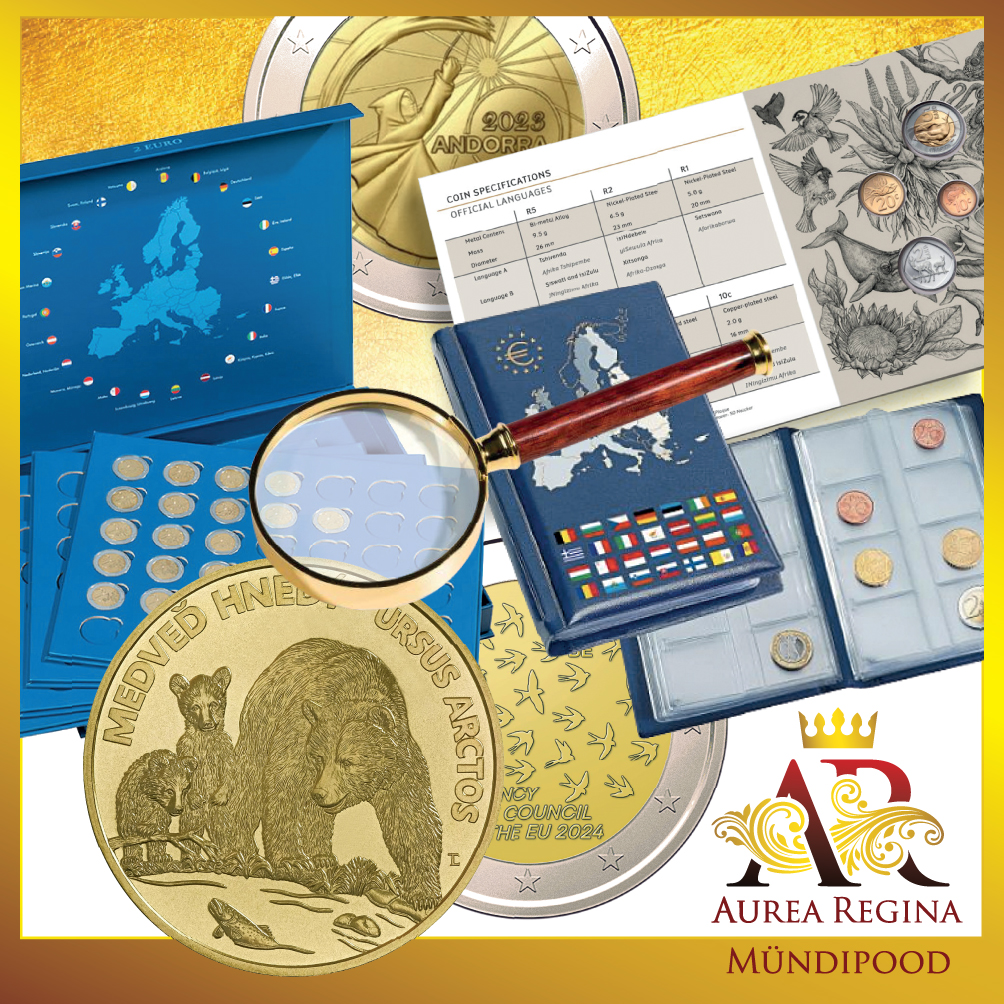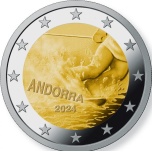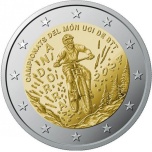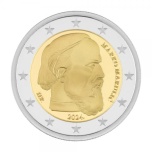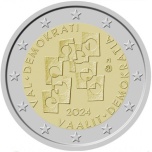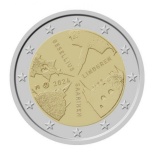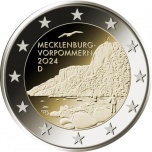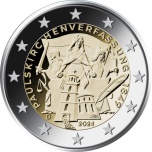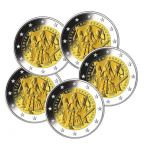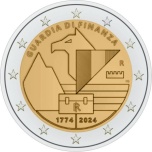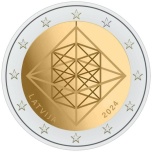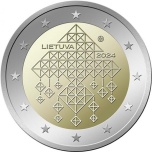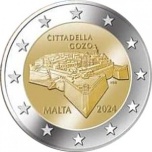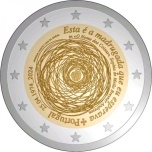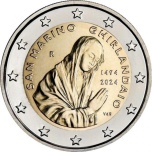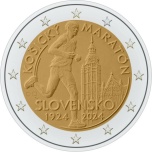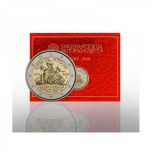2024
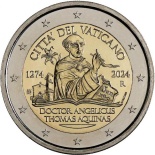
Sort By:
Display: as list / as grid
Feature: 100 years of skiing in Andorra
Description: It is considered that the first contacts of the Andorran population with skiing took place in 1924. Nowadays, skiing is the country's king of sports making Andorra a very popular destination thanks to its snow-capped mountains, spectacular landscapes and world-class ski resorts. The design of the coin commemorates the centenary of the practice of this sport in Andorra and reproduces the lower part of the silhouette of a skier together with the name of the issuing country ‘ANDORRA’ and the year of issue ‘2024’. The coin’s outer ring bears the 12 stars of the European flag.
Issuing volume: 60 000 coins
Description: It is considered that the first contacts of the Andorran population with skiing took place in 1924. Nowadays, skiing is the country's king of sports making Andorra a very popular destination thanks to its snow-capped mountains, spectacular landscapes and world-class ski resorts. The design of the coin commemorates the centenary of the practice of this sport in Andorra and reproduces the lower part of the silhouette of a skier together with the name of the issuing country ‘ANDORRA’ and the year of issue ‘2024’. The coin’s outer ring bears the 12 stars of the European flag.
Issuing volume: 60 000 coins
35,00 €
Feature: UCI Mountain Bike World Championships 2024
Description: This year, Andorra will host an important international sporting event: the UCI Mountain Bike World Championships 2024. The design of the coin shows a rider passing through a landscape showing the spectacular nature of this sport, with the inscription ‘CAMPIONATS DEL MÓN UCI DE BTT’ (UCI Mountain Bike World Championships 2024). The inscriptions of the issuing country ‘ANDORRA’ and the year of issuance ‘2024’ have been reproduced at the sides of the rider, as if they were another element of this sport. The coin’s outer ring bears the 12 stars of the European flag.
Issuing volume: 60 000 coins
Description: This year, Andorra will host an important international sporting event: the UCI Mountain Bike World Championships 2024. The design of the coin shows a rider passing through a landscape showing the spectacular nature of this sport, with the inscription ‘CAMPIONATS DEL MÓN UCI DE BTT’ (UCI Mountain Bike World Championships 2024). The inscriptions of the issuing country ‘ANDORRA’ and the year of issuance ‘2024’ have been reproduced at the sides of the rider, as if they were another element of this sport. The coin’s outer ring bears the 12 stars of the European flag.
Issuing volume: 60 000 coins
35,00 €
Feature: The 500th anniversary of Marko Marulić’s enduring legacy
Description: In recognition of this significant milestone, the Government of the Republic of Croatia has proclaimed 2024 as the Year of Marko Marulić. The central motif of the national side of the coin is the portrait of Marko Marulić (1450-1524), Croatian writer. Marko Marulić (Marul) was born in Split in 1450 and is a prominent representative of European Christian humanism and Renaissance epics. His literary works, mostly written in Latin, are comprised of works in verse and prose, his literary models being the Bible, the Church Fathers' philosophy and classical antiquity. He wrote the epic poem Judita, his magnum opus, in Croatian. It is the first artistic epic in Croatian literature composed in the Croatian language to contain the underlying poetics of Virgil and the Biblical epics. In it, Marulić achieved a true Renaissance synthesis of Croatian, Latin and Italian literary tradition, thus creating a masterpiece. Completed in 1501, it was first published twenty years later. The coin also features the inscriptions of the two-letter issuing country code "HR" (Croatia), the year of issuance "2024." and the words "MARKO MARULIĆ", which are all inscribed circularly along the edge of the coin's core. The coin’s outer ring bears the 12 stars of the European flag.
Issuing volume: 200 000 coins
Description: In recognition of this significant milestone, the Government of the Republic of Croatia has proclaimed 2024 as the Year of Marko Marulić. The central motif of the national side of the coin is the portrait of Marko Marulić (1450-1524), Croatian writer. Marko Marulić (Marul) was born in Split in 1450 and is a prominent representative of European Christian humanism and Renaissance epics. His literary works, mostly written in Latin, are comprised of works in verse and prose, his literary models being the Bible, the Church Fathers' philosophy and classical antiquity. He wrote the epic poem Judita, his magnum opus, in Croatian. It is the first artistic epic in Croatian literature composed in the Croatian language to contain the underlying poetics of Virgil and the Biblical epics. In it, Marulić achieved a true Renaissance synthesis of Croatian, Latin and Italian literary tradition, thus creating a masterpiece. Completed in 1501, it was first published twenty years later. The coin also features the inscriptions of the two-letter issuing country code "HR" (Croatia), the year of issuance "2024." and the words "MARKO MARULIĆ", which are all inscribed circularly along the edge of the coin's core. The coin’s outer ring bears the 12 stars of the European flag.
Issuing volume: 200 000 coins
17,00 €
Feature: Elections and democracy
Description: The design shows stylized ballots. Ballots consist of circles and rectangles. The subject is abstract, but still recognizable. There are eight ballots, and they are partially overlapped, creating smaller geometric shapes at the intersections of the overlapping tickets. The year 2024 is at the bottom. The lettering ‘FI’ is on the right-hand side slightly above the midline. The text VAALIT ♦ DEMOKRATIA rotates on the right-hand side of the money ring. The text VAL ♦ DEMOKRATI is circling the coin on the left-hand side. The coin’s outer ring bears the 12 stars of the European flag.
Issuing volume: 400 000 coins
Description: The design shows stylized ballots. Ballots consist of circles and rectangles. The subject is abstract, but still recognizable. There are eight ballots, and they are partially overlapped, creating smaller geometric shapes at the intersections of the overlapping tickets. The year 2024 is at the bottom. The lettering ‘FI’ is on the right-hand side slightly above the midline. The text VAALIT ♦ DEMOKRATIA rotates on the right-hand side of the money ring. The text VAL ♦ DEMOKRATI is circling the coin on the left-hand side. The coin’s outer ring bears the 12 stars of the European flag.
Issuing volume: 400 000 coins
10,00 €
Feature: Finnish Architecture
Description: The design shows the silhouettes of four buildings. The roof towers of the buildings point towards the centre. The texts ‘GESELLIUS’, ‘LINDGREN’, ‘SAARINEN’ and the indication of the issuing country ‘FI’, the mintmark and the year ‘2024’ run diagonally between the buildings. The texts and the silhouettes of the buildings form a clock-like composition on the circular image surface of the coin. The coin’s outer ring bears the 12 stars of the European flag.
Issuing volume: 400 000 coins
Description: The design shows the silhouettes of four buildings. The roof towers of the buildings point towards the centre. The texts ‘GESELLIUS’, ‘LINDGREN’, ‘SAARINEN’ and the indication of the issuing country ‘FI’, the mintmark and the year ‘2024’ run diagonally between the buildings. The texts and the silhouettes of the buildings form a clock-like composition on the circular image surface of the coin. The coin’s outer ring bears the 12 stars of the European flag.
Issuing volume: 400 000 coins
10,00 €
set of 5 coins (A; G; D; J, F)
Feature: Mecklenburg-Vorpommern
Description: The coin is dedicated to the German state (Land) of Mecklenburg-Western Pomerania. It is the second issuance in the second series of German 2-euro commemorative coins featuring the German states, or Länder. Each year, a coin pays tribute to one of the 16 Länder by depicting a significant building or landmark. The order of the states is based on the rotating presidency of the Bundesrat, which is one of the five permanent constitutional bodies of the Federal Republic of Germany and represents the interests of the Länder. The design shows the Königsstuhl, an iconic formation of chalk cliffs and beech forest located in Jasmund National Park on the island of Rügen. The cliffs are depicted from the perspective of the shoreline, thereby highlighting the monumentality of this unique natural landmark in a particularly effective manner. The beautifully detailed image provides scale through the combined rendering of sea, birdlife and humankind. The modern typography, in harmony with the flying seagull, is skilfully integrated into the relief. The upper half of the coin’s inner circle features the inscription ‘MECKLENBURG VORPOMMERN’, the year of issue ‘2024’, Germany’s issuing country code ‘D’ and, at the upper right, the letter ‘X’ as placeholder for the mint mark of the respective mint (‘A’, ‘D’, ‘F’, ‘G’ or ‘J’). The initials of the artist Michael Otto (from Rodenbach, Germany) are shown in the lower half of the inner circle. The coin’s outer ring bears the 12 stars of the European flag.
Issuing volume: 30 000 000 coins
Feature: Mecklenburg-Vorpommern
Description: The coin is dedicated to the German state (Land) of Mecklenburg-Western Pomerania. It is the second issuance in the second series of German 2-euro commemorative coins featuring the German states, or Länder. Each year, a coin pays tribute to one of the 16 Länder by depicting a significant building or landmark. The order of the states is based on the rotating presidency of the Bundesrat, which is one of the five permanent constitutional bodies of the Federal Republic of Germany and represents the interests of the Länder. The design shows the Königsstuhl, an iconic formation of chalk cliffs and beech forest located in Jasmund National Park on the island of Rügen. The cliffs are depicted from the perspective of the shoreline, thereby highlighting the monumentality of this unique natural landmark in a particularly effective manner. The beautifully detailed image provides scale through the combined rendering of sea, birdlife and humankind. The modern typography, in harmony with the flying seagull, is skilfully integrated into the relief. The upper half of the coin’s inner circle features the inscription ‘MECKLENBURG VORPOMMERN’, the year of issue ‘2024’, Germany’s issuing country code ‘D’ and, at the upper right, the letter ‘X’ as placeholder for the mint mark of the respective mint (‘A’, ‘D’, ‘F’, ‘G’ or ‘J’). The initials of the artist Michael Otto (from Rodenbach, Germany) are shown in the lower half of the inner circle. The coin’s outer ring bears the 12 stars of the European flag.
Issuing volume: 30 000 000 coins
22,00 €
Feature: Mecklenburg-Vorpommern
Description: The coin is dedicated to the German state (Land) of Mecklenburg-Western Pomerania. It is the second issuance in the second series of German 2-euro commemorative coins featuring the German states, or Länder. Each year, a coin pays tribute to one of the 16 Länder by depicting a significant building or landmark. The order of the states is based on the rotating presidency of the Bundesrat, which is one of the five permanent constitutional bodies of the Federal Republic of Germany and represents the interests of the Länder. The design shows the Königsstuhl, an iconic formation of chalk cliffs and beech forest located in Jasmund National Park on the island of Rügen. The cliffs are depicted from the perspective of the shoreline, thereby highlighting the monumentality of this unique natural landmark in a particularly effective manner. The beautifully detailed image provides scale through the combined rendering of sea, birdlife and humankind. The modern typography, in harmony with the flying seagull, is skilfully integrated into the relief. The upper half of the coin’s inner circle features the inscription ‘MECKLENBURG VORPOMMERN’, the year of issue ‘2024’, Germany’s issuing country code ‘D’ and, at the upper right, the letter ‘X’ as placeholder for the mint mark of the respective mint (‘A’, ‘D’, ‘F’, ‘G’ or ‘J’). The initials of the artist Michael Otto (from Rodenbach, Germany) are shown in the lower half of the inner circle. The coin’s outer ring bears the 12 stars of the European flag.
Issuing volume: 30 000 000 coins
Description: The coin is dedicated to the German state (Land) of Mecklenburg-Western Pomerania. It is the second issuance in the second series of German 2-euro commemorative coins featuring the German states, or Länder. Each year, a coin pays tribute to one of the 16 Länder by depicting a significant building or landmark. The order of the states is based on the rotating presidency of the Bundesrat, which is one of the five permanent constitutional bodies of the Federal Republic of Germany and represents the interests of the Länder. The design shows the Königsstuhl, an iconic formation of chalk cliffs and beech forest located in Jasmund National Park on the island of Rügen. The cliffs are depicted from the perspective of the shoreline, thereby highlighting the monumentality of this unique natural landmark in a particularly effective manner. The beautifully detailed image provides scale through the combined rendering of sea, birdlife and humankind. The modern typography, in harmony with the flying seagull, is skilfully integrated into the relief. The upper half of the coin’s inner circle features the inscription ‘MECKLENBURG VORPOMMERN’, the year of issue ‘2024’, Germany’s issuing country code ‘D’ and, at the upper right, the letter ‘X’ as placeholder for the mint mark of the respective mint (‘A’, ‘D’, ‘F’, ‘G’ or ‘J’). The initials of the artist Michael Otto (from Rodenbach, Germany) are shown in the lower half of the inner circle. The coin’s outer ring bears the 12 stars of the European flag.
Issuing volume: 30 000 000 coins
7,00 €
Feature: The 175th anniversary of the Frankfurt Constitution (also known as the St Paul’s Church Constitution, which was the first attempt to create a unified German nation state.)
Description: The design features several thematic layers. In the foreground is a perspective depiction of St Paul’s Church with the representatives of the national constitutional assembly filing in. This overlays a rendering of the constitutional document and a quill, representing the outcome of the Frankfurt Parliament. Finally, the design is crowned by three female allegories – Unity, Justice and Freedom – and the tricolour flag of black, red and gold. The vibrant three- dimensional relief evokes the timelessness of the basic democratic principles that were put down in writing for the first time and in a foundational way in the Frankfurt Constitution. The coin’s inner ring also features the inscription ‘PAULSKIRCHENVERFASSUNG 1849’ (‘St Paul’s Church Constitution 1849’) and, at the bottom, the year of issue ‘2024’, Germany’s issuing country code ‘D’, the mint mark of the respective mint (‘A’, ‘D’, ‘F’, ‘G’ or ‘J’), and the initials of the artist, Bodo Broschat from Berlin. The coin’s outer ring bears the 12 stars of the European flag.
Issuing volume: 30 000 000 coins
Description: The design features several thematic layers. In the foreground is a perspective depiction of St Paul’s Church with the representatives of the national constitutional assembly filing in. This overlays a rendering of the constitutional document and a quill, representing the outcome of the Frankfurt Parliament. Finally, the design is crowned by three female allegories – Unity, Justice and Freedom – and the tricolour flag of black, red and gold. The vibrant three- dimensional relief evokes the timelessness of the basic democratic principles that were put down in writing for the first time and in a foundational way in the Frankfurt Constitution. The coin’s inner ring also features the inscription ‘PAULSKIRCHENVERFASSUNG 1849’ (‘St Paul’s Church Constitution 1849’) and, at the bottom, the year of issue ‘2024’, Germany’s issuing country code ‘D’, the mint mark of the respective mint (‘A’, ‘D’, ‘F’, ‘G’ or ‘J’), and the initials of the artist, Bodo Broschat from Berlin. The coin’s outer ring bears the 12 stars of the European flag.
Issuing volume: 30 000 000 coins
7,00 €
Feature: The 175th anniversary of the Frankfurt Constitution (also known as the St Paul’s Church Constitution, which was the first attempt to create a unified German nation state.)
Description: The design features several thematic layers. In the foreground is a perspective depiction of St Paul’s Church with the representatives of the national constitutional assembly filing in. This overlays a rendering of the constitutional document and a quill, representing the outcome of the Frankfurt Parliament. Finally, the design is crowned by three female allegories – Unity, Justice and Freedom – and the tricolour flag of black, red and gold. The vibrant three- dimensional relief evokes the timelessness of the basic democratic principles that were put down in writing for the first time and in a foundational way in the Frankfurt Constitution. The coin’s inner ring also features the inscription ‘PAULSKIRCHENVERFASSUNG 1849’ (‘St Paul’s Church Constitution 1849’) and, at the bottom, the year of issue ‘2024’, Germany’s issuing country code ‘D’, the mint mark of the respective mint (‘A’, ‘D’, ‘F’, ‘G’ or ‘J’), and the initials of the artist, Bodo Broschat from Berlin. The coin’s outer ring bears the 12 stars of the European flag.
Issuing volume: 30 000 000 coins
Description: The design features several thematic layers. In the foreground is a perspective depiction of St Paul’s Church with the representatives of the national constitutional assembly filing in. This overlays a rendering of the constitutional document and a quill, representing the outcome of the Frankfurt Parliament. Finally, the design is crowned by three female allegories – Unity, Justice and Freedom – and the tricolour flag of black, red and gold. The vibrant three- dimensional relief evokes the timelessness of the basic democratic principles that were put down in writing for the first time and in a foundational way in the Frankfurt Constitution. The coin’s inner ring also features the inscription ‘PAULSKIRCHENVERFASSUNG 1849’ (‘St Paul’s Church Constitution 1849’) and, at the bottom, the year of issue ‘2024’, Germany’s issuing country code ‘D’, the mint mark of the respective mint (‘A’, ‘D’, ‘F’, ‘G’ or ‘J’), and the initials of the artist, Bodo Broschat from Berlin. The coin’s outer ring bears the 12 stars of the European flag.
Issuing volume: 30 000 000 coins
22,00 €
Feature: The 250th anniversary of the foundation of the Guardia di Finanza Corps
Description: The design depicts, in the centre, a stylized version of the heraldic symbol of Guardia di Finanza Corps: it portrays the concept of security and provides a future vision of the Corps’ role celebrating the past, by combining it with the years to come and challenges they will continue to face. This emblem includes different elements: mountain, sea and the sky, which are the natural environments where Corps operate; the Griffon, a mythological animal which, according to the legend, supervises protection of the Treasury, represented by the chest of the State, and the turreted crown. At the top, in semi-circle, is the inscription ‘GUARDIA DI FINANZA’. Below, ‘RI’, acronym of the Italian Republic and the dates ‘1774-2024’, year of the establishment of the Guardia di Finanza Corps and year of coin’s issue respectively; on the right, ‘R’, identifying the Mint of Rome and ‘MB’, the initials of designer Marta Bonifacio. The coin’s outer ring bears the 12 stars of the European flag.
Issuing volume: 3 000 000 coins
Description: The design depicts, in the centre, a stylized version of the heraldic symbol of Guardia di Finanza Corps: it portrays the concept of security and provides a future vision of the Corps’ role celebrating the past, by combining it with the years to come and challenges they will continue to face. This emblem includes different elements: mountain, sea and the sky, which are the natural environments where Corps operate; the Griffon, a mythological animal which, according to the legend, supervises protection of the Treasury, represented by the chest of the State, and the turreted crown. At the top, in semi-circle, is the inscription ‘GUARDIA DI FINANZA’. Below, ‘RI’, acronym of the Italian Republic and the dates ‘1774-2024’, year of the establishment of the Guardia di Finanza Corps and year of coin’s issue respectively; on the right, ‘R’, identifying the Mint of Rome and ‘MB’, the initials of designer Marta Bonifacio. The coin’s outer ring bears the 12 stars of the European flag.
Issuing volume: 3 000 000 coins
7,00 €
Feature: Himmeli
Description: Himmeli is an ancient Latvian Christmas decoration. The design shows the traditional module shape the decoration is made up: the octahedron which consists of 12 interconnected straws and it symbolises the year with its 12 months. The himmeli is one of the oldest Christmas decorations, being in use long before the Christmas tree. At the bottom left is inscribed the name of the country of issuance “LATVIJA”. At the bottom right is inscribed the year of issuance “2024”. The coin’s outer ring bears the 12 stars of the European flag.
Issuing volume: 413 000 coins
Description: Himmeli is an ancient Latvian Christmas decoration. The design shows the traditional module shape the decoration is made up: the octahedron which consists of 12 interconnected straws and it symbolises the year with its 12 months. The himmeli is one of the oldest Christmas decorations, being in use long before the Christmas tree. At the bottom left is inscribed the name of the country of issuance “LATVIJA”. At the bottom right is inscribed the year of issuance “2024”. The coin’s outer ring bears the 12 stars of the European flag.
Issuing volume: 413 000 coins
7,00 €
Feature: Lithuanian tradition of straw gardens inscribed on the UNESCO Representative List of the Intangible Cultural Heritage of Humanity
Description: The design features a stylised straw garden consisting of geometric shapes of varying sizes, one tip of which is pointed upwards (to the sky) and the other downwards (to the underground). The design also bears the inscription “LIETUVA” (LITHUANIA), the year of issue (2024) and the mintmark of the Lithuanian Mint. Straw gardens are a Baltic cultural tradition that carries decorative and ceremonial significance and is related to well-being and spirituality. The national side of the coin is designed by Tomas Dragūnas. The coin’s outer ring bears the 12 stars of the European flag.
Issuing volume: 500 000 coins
Description: The design features a stylised straw garden consisting of geometric shapes of varying sizes, one tip of which is pointed upwards (to the sky) and the other downwards (to the underground). The design also bears the inscription “LIETUVA” (LITHUANIA), the year of issue (2024) and the mintmark of the Lithuanian Mint. Straw gardens are a Baltic cultural tradition that carries decorative and ceremonial significance and is related to well-being and spirituality. The national side of the coin is designed by Tomas Dragūnas. The coin’s outer ring bears the 12 stars of the European flag.
Issuing volume: 500 000 coins
7,00 €
Feature: Iċ-Ċittadella (The Citadel)
Description: Description of the design: The design was created by Noel Galea Bason and depicts the walled city known locally as ‘Iċ-Ċittadella’ (The Citadel) on the island of Gozo, which is the second largest island forming the Maltese archipelago. In their present form, the fortifications encircling the ‘Ċittadella’ were built and modified by the Order of St John. The design shows a depiction of the city with its fortified walls. At the bottom left is the inscription of the issuing country ‘MALTA’ and at the bottom right is the year of issuance ‘2024’. At the top is the inscription ‘ĊITTADELLA’ and underneath is the inscription ‘GOZO’. This coin is intended to be part of a series dedicated to Maltese walled cities e.g. Mdina and Valletta which are an intrinsic part of Maltese and European cultural heritage. The coin’s outer ring bears the 12 stars of the European flag.
Issuing volume: 85 500 coins
Description: Description of the design: The design was created by Noel Galea Bason and depicts the walled city known locally as ‘Iċ-Ċittadella’ (The Citadel) on the island of Gozo, which is the second largest island forming the Maltese archipelago. In their present form, the fortifications encircling the ‘Ċittadella’ were built and modified by the Order of St John. The design shows a depiction of the city with its fortified walls. At the bottom left is the inscription of the issuing country ‘MALTA’ and at the bottom right is the year of issuance ‘2024’. At the top is the inscription ‘ĊITTADELLA’ and underneath is the inscription ‘GOZO’. This coin is intended to be part of a series dedicated to Maltese walled cities e.g. Mdina and Valletta which are an intrinsic part of Maltese and European cultural heritage. The coin’s outer ring bears the 12 stars of the European flag.
Issuing volume: 85 500 coins
45,00 €
Feature: The 50th anniversary of the 25th of April 1974
Description: The 25th of April 1974 is the date of the revolution that marked the establishment of the democratic rule in Portugal and the beginning of a journey of profound economic, social and cultural transformations that led to the Europeanization of the country. At the centre of the design, a carnation symbolizes the revolution, surrounded by multiple eccentric circles that suggest that people’s actions and beliefs may change over the years, but remain essentially true to the principles of the revolution. On the edge, on the right, the verse ‘Esta é a madrugada que eu esperava’ [This is the dawn I have been waiting for], and the name of its author, poet ‘Sophia de Mello Breyner Andresen’; and on the left by the national coat of arms, the captions ‘Portugal’ and ‘25 April 1974_2024’, followed by the name of the designer and the mintmark ‘Casa da Moeda’, the name of the Portuguese Mint. The coin’s outer ring bears the 12 stars of the European flag.
Issuing volume: 515 000 coins
Description: The 25th of April 1974 is the date of the revolution that marked the establishment of the democratic rule in Portugal and the beginning of a journey of profound economic, social and cultural transformations that led to the Europeanization of the country. At the centre of the design, a carnation symbolizes the revolution, surrounded by multiple eccentric circles that suggest that people’s actions and beliefs may change over the years, but remain essentially true to the principles of the revolution. On the edge, on the right, the verse ‘Esta é a madrugada que eu esperava’ [This is the dawn I have been waiting for], and the name of its author, poet ‘Sophia de Mello Breyner Andresen’; and on the left by the national coat of arms, the captions ‘Portugal’ and ‘25 April 1974_2024’, followed by the name of the designer and the mintmark ‘Casa da Moeda’, the name of the Portuguese Mint. The coin’s outer ring bears the 12 stars of the European flag.
Issuing volume: 515 000 coins
7,00 €
Feature: 530th anniversary of the death of Ghirlandaio
Description: In the centre is the Virgin in prayer, a detail of the painting ‘Adoration of the Shepherds’ by Domenico Ghirlandaio, kept in the Sassetti Chapel of Santa Trinità (Florence). On the left are the inscription ‘SAN MARINO’ and the letter ‘R’, the identifier of the Mint of Rome; on the right, the inscription ‘GHIRLANDAIO’ and the dates ‘1494’ and ‘2024’; at the bottom, the initials of the artist, Valerio de Seta (‘VdS’). The coin’s outer ring bears the 12 stars of the European flag.
Issuing volume: 56 000 coins
Description: In the centre is the Virgin in prayer, a detail of the painting ‘Adoration of the Shepherds’ by Domenico Ghirlandaio, kept in the Sassetti Chapel of Santa Trinità (Florence). On the left are the inscription ‘SAN MARINO’ and the letter ‘R’, the identifier of the Mint of Rome; on the right, the inscription ‘GHIRLANDAIO’ and the dates ‘1494’ and ‘2024’; at the bottom, the initials of the artist, Valerio de Seta (‘VdS’). The coin’s outer ring bears the 12 stars of the European flag.
Issuing volume: 56 000 coins
65,00 €
Feature: 100th anniversary of the Košice Peace Marathon
Description: The design depicts, on the left side, a marathon runner and, on the right side, a detail of St Elizabeth’s Cathedral, one of the architectural landmarks of Košice. Inscribed across the lower part of the design are the name of the issuing country ‘SLOVENSKO’ and, below it, the marathon’s inaugural year ‘1924’ and the coin’s year of issuance ‘2024’. The inscription ‘KOŠICKÝ MARATÓN’ runs along the edge of the upper half of the design. Next to the lower left edge is the mint mark of the Kremnica Mint (Mincovňa Kremnica), consisting of the letters ‘MK’ placed between two dies. To the right of it are the stylised initials ‘LR’, referring to the national side’s designer Roman Lugár. The coin’s outer ring bears the 12 stars of the European flag.
Issuing volume: 1 000 000 coins
Description: The design depicts, on the left side, a marathon runner and, on the right side, a detail of St Elizabeth’s Cathedral, one of the architectural landmarks of Košice. Inscribed across the lower part of the design are the name of the issuing country ‘SLOVENSKO’ and, below it, the marathon’s inaugural year ‘1924’ and the coin’s year of issuance ‘2024’. The inscription ‘KOŠICKÝ MARATÓN’ runs along the edge of the upper half of the design. Next to the lower left edge is the mint mark of the Kremnica Mint (Mincovňa Kremnica), consisting of the letters ‘MK’ placed between two dies. To the right of it are the stylised initials ‘LR’, referring to the national side’s designer Roman Lugár. The coin’s outer ring bears the 12 stars of the European flag.
Issuing volume: 1 000 000 coins
7,00 €
Feature: 250 years of National and University Library (Narodna in univerzitetna knjižnica)
Description: Slightly tilted National and University Library’s doorhandle with Pegasus, a winged divine stallion, used as a symbolic guide for library’s visitors to the world of knowledge by the architect Jože Plečnik, is displayed on the coin. Doorhandle is the first contact with the institution that invites us to the world of knowledge and inspiration. At the top, in semi-circle, is the inscription “NARODNA IN UNIVERZITETNA KNJIŽNICA“. At the bottom are the name of the country of issuance “SLOVENIJA” and the year of issuance “2024”. The coin’s outer ring bears the 12 stars of the European flag.
Issuing volume: 1 000 000 coin
Description: Slightly tilted National and University Library’s doorhandle with Pegasus, a winged divine stallion, used as a symbolic guide for library’s visitors to the world of knowledge by the architect Jože Plečnik, is displayed on the coin. Doorhandle is the first contact with the institution that invites us to the world of knowledge and inspiration. At the top, in semi-circle, is the inscription “NARODNA IN UNIVERZITETNA KNJIŽNICA“. At the bottom are the name of the country of issuance “SLOVENIJA” and the year of issuance “2024”. The coin’s outer ring bears the 12 stars of the European flag.
Issuing volume: 1 000 000 coin
7,00 €
Feature: The 750th anniversary of the death of St. Thomas Aquinas
Description: The design features St. Thomas Aquinas in the foreground in the vestments of the Dominican Order to which he belonged. In his left hand he holds a volume of his most important work, the Summa Theologiae, and in the other a pen. A shining sun stands out on the saint’s chest, a symbol of his great wisdom. Among the various titles he received, he is most widely known as the “Angelic Doctor”, which is quoted below and which glorifies his exceptional purity of soul and body. In the background on the left is the lily, a symbol of chastity, and the Church of St. Thomas of Roccasecca, the first religious building in the world built in honor of St. Thomas Aquinas, declared a saint on July 18, 1323 by Pope John XXII. At the top is the inscription “CITTÀ DEL VATICANO”. At the left is the year “1274” and at the right the year “2024” and underneath it are the mintmark “R” and the name of the artist “A. CICCONI”. The coin’s outer ring bears the 12 stars of the European flag.
Issuing volume: 82 900 coins
Description: The design features St. Thomas Aquinas in the foreground in the vestments of the Dominican Order to which he belonged. In his left hand he holds a volume of his most important work, the Summa Theologiae, and in the other a pen. A shining sun stands out on the saint’s chest, a symbol of his great wisdom. Among the various titles he received, he is most widely known as the “Angelic Doctor”, which is quoted below and which glorifies his exceptional purity of soul and body. In the background on the left is the lily, a symbol of chastity, and the Church of St. Thomas of Roccasecca, the first religious building in the world built in honor of St. Thomas Aquinas, declared a saint on July 18, 1323 by Pope John XXII. At the top is the inscription “CITTÀ DEL VATICANO”. At the left is the year “1274” and at the right the year “2024” and underneath it are the mintmark “R” and the name of the artist “A. CICCONI”. The coin’s outer ring bears the 12 stars of the European flag.
Issuing volume: 82 900 coins
59,00 €


